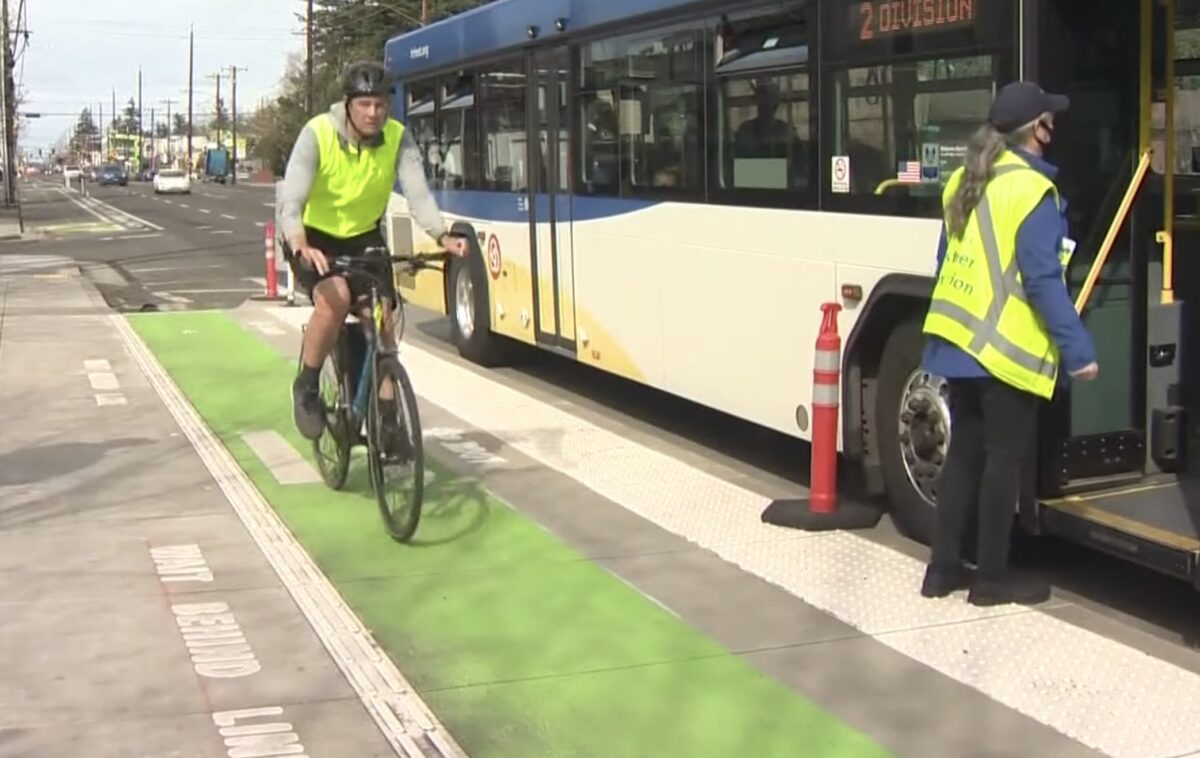
A news report on TriMet’s new Division Street bus station designs that aired Monday on KGW warrants a discussion of Oregon traffic law and how best to manage a new type of shared space.
As we reported last last month, TriMet opened two new stations (at SE 130th and 135th) as part of their (still in construction) Division Transit Project. The agency spent years trying to come up with a design that would allow bicycle users to pass through, while not encouraging conflicts with bus riders.
Advertisement
The way I understood the new design to work was pretty simple. If there are people present, bicycle riders would need to stop and wait. That’s basic human decency and it’s Oregon law since the loading/unloading area is technically a hybrid sidewalk/crosswalk in this context.
But what if only the bus is present and there are no pedestrians anywhere to be seen?
My ears perked up when I saw the KGW story above. As a bicycle user rode through the station, the reporter said, “… It may take some time before everyone gets the new system. This guy rode right on through with a bus at the stop.”
KGW then shared an animation from TriMet and described it like this:
“Cyclists can ride through the station in their lane, but when a bus pulls up to the curb, cyclists are required to stop before the pedestrian crosswalk area, allowing passengers to safely get on or off the bus.”
This raised a red flag for me, because stopping when a bus is present is a lot different than stopping when a pedestrian is present. Stopping at a crosswalk/sidewalk (or station loading area in this case) for the presence of a bus has no basis in Oregon law and could result in lengthy stops for well-meaning riders and/or confusion by others who aren’t sure if they are required to stop or not.
I asked TriMet spokesperson Tia York to clarify.
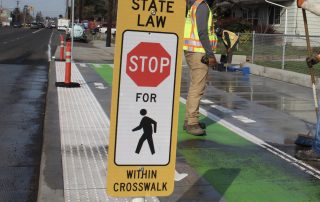
(Photo: TriMet)
At first she pointed out Oregon statutes that require bicycle riders to yield to people on sidewalks and in crosswalks. Those laws are important to follow, but they don’t the situation where a bus is present but people aren’t.
In a follow-up York clarified that, “When a bus stops at the station, people should presume there will be people coming and going to the bus in the marked crosswalks in the bike lane within a few seconds. For cyclists, that does mean stopping when the bus pulls up.”
I understand TriMet’s concern here; and I hope bicycle and bus riders are exceedingly cautious at these stations. But I also worry that this creates a confusing grey area that has no precedent or standing in the law.
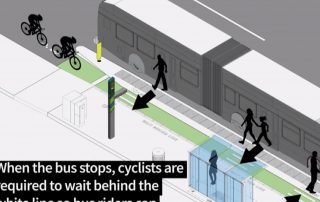
For example, Oregon law requires people to enter the street and/or make a motion that they want to use a crossing before other users are legally obligated to stop for them. TriMet is saying bicycle riders must do something new and different: Stop and wait in expectation of a person leaving/entering the bus loading crossing area.
What if a bus operator is laying over? Or doing paperwork or some other behavior that requires a prolonged stop? This would put an unfair burden on bicycle users who would have to remain stopped until the bus left the station.
York said buses that use these stations will have much shorter stops than usual due to all-door boarding and the fact that the raised platforms don’t require kneeling. Bus operators also don’t have to wait for a break in traffic since the lane is bus-only.
Hopefully this doesn’t become an issue, but we know when it comes to traffic laws and etiquette, confusion breeds non-compliance, and non-compliance breeds contempt — especially when it comes from an oft-maligned group like “cyclists”. Perhaps a solution would be a special “STOP” light or paddle that flips out of the right rear of the bus that’s engaged by the operator only during active loading and unloading?
Please don’t misunderstand me here: Bicycle riders need to chill out at these stations and should never blow through them if people are near the station (whether a bus is present or not). I just want to raise the issue in hopes that it never becomes one.
Have you used these stations yet? What was your experience?
— Jonathan Maus: (503) 706-8804, @jonathan_maus on Twitter and jonathan@bikeportland.org
— Get our headlines delivered to your inbox.
— Support this independent community media outlet with a one-time contribution or monthly subscription.



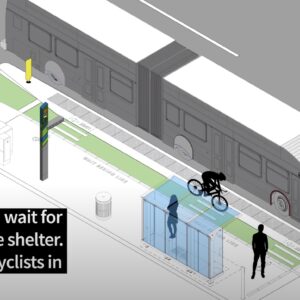
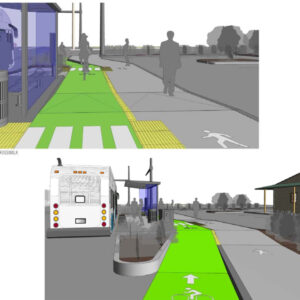

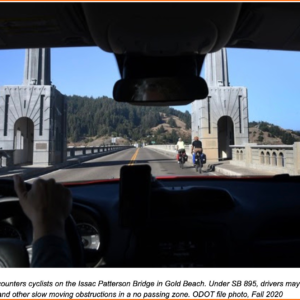
Thanks for reading.
BikePortland has served this community with independent community journalism since 2005. We rely on subscriptions from readers like you to survive. Your financial support is vital in keeping this valuable resource alive and well.
Please subscribe today to strengthen and expand our work.
I think the biggest conflict would be people getting off the bus. You don’t expect to be stepping into a lane of traffic when you get off a bus and it doesn’t look like there is really room for riders to wait for a bike to pass by.
Being sarcastic here, but maybe the busses need a foldout arm with a stop sign like the school busses have.
Did you read the story Chris? I suggested that same thing at the end! I think perhaps a foldout arm might be a good idea.
Probably too hard to program such a device to only turn on for this type of stop.
Yes I hear you, but I was thinking it would be operated manually by the driver?
Not at all. LED sign on the back of the bus (right side) programmed through the light control module to illuminate when the bus is stopped.
Sure but programming and maintaining the systems integration with the CAD AVL to only do this at specific stops with this issue is complex.
1’~2′ diameter x 6′ long inflatable arm (like those vertical dancing air noodle things)
Soft enough that a high speed impact won’t directly injure a cyclist but it would soak up enough inertia to reduce the likelihood of serious injury of any deboarding bus passengers.
I’m really frustrated by this style of bus stop. I read into it that Trimet is aware of conflicts with cyclists as the bus docks to the curb (in normal stops). So instead of really understanding this conflict, they shift the burden onto the cyclist. I don’t think this is fair and reasonable design in general. Because cyclists already have a ton of inputs to process and having to predict a “heard rush” from one side of the bike lane to the other is a bad design. Thanks Trimet.
I ride streets with bus routes all of the time. Buses are predictable and it’s easy to understand their timing once you’ve encountered several on that street.
You can choose to be in conflict with their stops or ride to dissipate this conflict. It’s mostly up to the rider.
Well, yes and no. The primary reason PBoT redesigned Williams, for example, was bus conflict. When it is a heavily traveled route by both modes, conflict is inevitable. Conflict being an euphemism for death/injury of a person on a bike.
But to your point on Division specifically, particularly outer division where little to no safe infrastructure aside from these bus stops exist, I expect the number of people on bikes to be negligible. The probability of conflict is very low. If PBoT were to make this route safe with protected intersections and connect it to the rest of the city, we may see more ridership.
Yep, Hawthorn Bridge, west bound, there’s that one bus stop that usually doesn’t get used. Every now an then, someone will get on / off. That section of the bridge path is a bicycle freeway, so it’s pretty dicey when the bus actually stops there.
How about stop, and if your patience with the bus runs out, walk your bike through the unloading zone?
IDK, if I wanted something I had to walk, I’d’ve gotten a dog.
The bus stop on the west bound Hawthorn bridge has always seemed a bad design. Now it seems to be the model. Considering the lack of traffic law enforcement and the independence ( perceived privilege?) of cyclists, the rule to stop for busses or even pedestrians will not be followed.
It’s not necessary to stop for busses, just like it isn’t necessary to stop for stop signs. If you see a parked bus, slow your roll. If it has literally just stopped at the curb, you should expect people to be getting off. If you roll up on a bus that has been sitting there for minutes, just go slow, but no need to stop. Drivers sit at stops for a lot of reasons (fare disputes, ahead of schedule, layover, etc).
Exactly, Idaho stop. I really think this is a non-issue on outer division, although good on Tri-Met that they pre-empt any potential conflict.
I’ve been watching the progress on Division with a great deal of skepticism.
What started as a $375 million project when first proposed some 10 years ago has been ratcheted back to the $175 million for the Division transit project. The political winds were blowing the wrong way at the time the project was funded.
The bike crossings at the stations will take some time to get used and bike/ped conflicts will be likely. We’ll ultimately get used to the new design. What scares me most will be conflicts of automobiles and light trucks making U-turns when the center medians are completed. Large vehicles will encroach into the bike lanes when making a U-turns. Not a good scenario.
I typically don’t ride Division unless I have to. The I-205 interchange on Division will be getting a new facelift for 2021-2022. An ODOT STIP project. This is the scariest part of Division. Well, maybe 122nd and Division. No wait, 82nd and Division. It’s all scary.
I live off 80th and Division so I see what traffics like up and down division. What I’ve noticed missing from the bike lanes: people riding bikes. I rarely see people bike commutting, maybe a few here and there. Unless there’s a major uptick in riding, I don’t see these new designs being a major point of conflict; especially east of 82nd.
Exactly Matt. Outer Division has no safe design elements other than these protected bus stops. West of 82nd is tough due to its width (but the ride along Lincoln on Tabor is worth the extra jog IMO). East of 82nd: Removing parking and adding occasional bumpers as well as (most importantly) designing protected intersections would make this a safe/practical route. The other option would be to remove 2 lanes of traffic and have a parking protected design. Either scenario is incredibly unlikely based on PBoT’s MO: evaluate each street in isolation and maintain traffic counts. Otherwise, my dad, friends and I will continue to avoid Division like the plague.
I would think that subsection 3 of ORS 811.165 would allow cyclists to proceed cautiously through these stops even if a bus is present. As you say, the right thing to do would be to stop until you’re sure that no one is coming off the bus. And as most of us with experience with transit vehicles knows, you don’t know that another person isn’t coming until the door is closed. But ORS 811.165 doesn’t seem to require you to stop, just proceed cautiously, so I’d be surprised if you couldn’t fight a ticket based on it.
“Bus operators also don’t have to wait for a break in traffic since the lane is bus-only.”
Unfortunately the TriMet spokesperson is under the impression that they’re building a much better project than they are. There will be very few bus only lanes.
This whole thing is so classic Portland. The new design is expensive, over-engineered, fails to solve the old problem, and creates new problems all in the name of making motorist happy
Does it? The standard approach is that the bus crosses the bike lane, moving out of the right lane (yay says the motorist stuck behind the bus). Then the bus attempts to merge back into traffic, who mostly ignore the bus (yay says the a-hole motorist). This solution seems to be much better for bus riders and drivers, and marginally worse for motorists and cyclists.
I don’t ride division and maybe it has more room than it appears to have but the standard practice I see is that the bus doesn’t have enough room to pull fully out of the lane so motorist then choose to veer into oncoming traffic to go around the bus.
Division east of Mt. Tabor is 5 lanes, then after 82nd it opens up into 5 lanes plus parking on the sides. It is huge, wide, and fast, with tons of opportunity for right hooks and left crosses.
Why can’t they just put a “stop” sign on the back of the bus, similar to a school bus sign, to indicate to cyclists if it is OK to pass or if they need to stop?
Let’s say that cyclists are to stop when a bus is there because people are unloading. From the still you posted in the article, there isn’t enough room for the number of cyclists we should be designing for (if we really and truly want to meet our cycling goals) to stop and not be in the perpendicular intersection. IMO, this is almost a bigger deal than the inherent ped/bike conflict of this design — the implementation is creating a bike/car conflict BY DESIGN.
The planning documents and spokepeople keep *saying* we want to get to XX% mode share. But we aren’t designing and building for that volume. Just try counter-commuting through the Rose Quarter and you’ll see that the lanes aren’t wide enough to support the current volume of cyclists, let alone what we should be designing for. Imagine riding the weird/terrible intersection of NE 37th & Prescott with any increase in the volume of cyclists?
We can build and widen roads based on future demand (and end up with wide speedways) and not blink. But we build and design non-car infrastructure not based on any projections of rider volume, as far as I’ve been able to tell.
Spot on Carrie. This is a result of PBoT’s flawed design process. It is very easy to look at a traffic count for cars and maintain that # in avoidance of any publicity. It is equally easy to ignore or intuit any potential increase in cycling because 1) the publicity if ignoring safety advocates is virtually nonexistent and 2) there is a relative paucity of current bike counts and no data/estimates for future counts.
To be sure engineers can reasonably estimate the number of cyclists on a given street were we to have a safe and separated network of bike lanes. Unfortunately, the current manner (above) of evaluating streets precludes any substantive safety improvements.
Thanks for posting, Most bike riders will be cautious. I’m not really concerned about a bike rider getting nabbed by an overzealous PPB traffic patrol officer….oh wait a minute there aren’t any of those anymore anyway. So just be careful and ride. You don’t need to be concerned about enforcement. Remember, this is Portland.
The design concept attempts to work within existing lane space, and provides no space for unloading. Amsterdam has median islands for transit, but the design provides space for loading and unloading, and you don’t see pedestrians (except tourists) stepping into the bike lane. Mostly because design, law, and etiquette discourage such behaviors. I don’t yet ride on streets that have these transit islands, and hope to avoid doing so.
This reminds me of a California Vehicle Code provision about streetcars, and cable cars. When a streetcar or cable car is at a stop where pedestrians have to cross a traffic lane to get to the middle-of-the-street streetcar, drivers are required to stop behind the streetcar until it finishes loading/unloading, and moves on. This sounds analogous. But may require a Vehicle Code fix.
The biggest problem I see with this design is that you are going to be expected to stop over and over again because if you wait for the bus to go you will then catch it again at the next stop. To be honest if there are people getting on and off I am probably going to be passing the bus on the left in a situation like this not stopping, and overall that doesn’t seem like the safest way to set this up.
But that’s what you would do now, right? pass the bus on the left? Seems like status quo.
except the bus would usually pull over blocking the bike lane on the right now but leaving more space on the left. I would say that it feels a little less safe to pass on the left with the new design, but most people probably wouldn’t feel comfortable passing on the left with either design. Seems like a better design would be an island right next to where the bus stops for people to stand and wait and a bike lane that runs outside of that. This eliminates the possibility of someone stepping off the bus into the bike lane blindly.
With this new design, the bus stops in the right-hand vehicle lane, so passing on the left is going to involve merging with all of the cars behind the bus, who are all trying to get in the left lane to pass the bus as quickly as possible. Good luck.
I believe this law applies.
811.165 Failure to stop for passenger loading of public transit vehicle; penalty. (1) A person commits the offense of failure to stop for passenger loading of a public transit vehicle if the person is the driver of a vehicle overtaking a public transit vehicle described in this section that is stopped or about to stop for the purpose of receiving or discharging any passenger and the person does not:
(a) Stop the overtaking vehicle to the rear of the nearest running board or door of the public transit vehicle; and
(b) Keep the vehicle stationary until all passengers have boarded or alighted therefrom and reached a place of safety.
(2) This section applies to the following public transit vehicles:
(a) Commercial buses; and
(b) Rail fixed guideway public transportation system vehicles.
(3) A person is not in violation of this section if the person passes a public transit vehicle:
(a) Upon the left of any public transit vehicle described in this section on a one-way street; or
(b) At a speed not greater than is reasonable and proper and with due caution for the safety of pedestrians when:
(A) The public transit vehicle has stopped at the curb; or
(B) Any area or space has been officially set apart within the roadway for the exclusive use of pedestrians and the area or space is so protected or marked or indicated by adequate signs as to be plainly visible at all times while set apart as a safety zone.
(4) The offense described in this section, failure to stop for passenger loading of public transit vehicle, is a Class B traffic violation. [1983 c.338 §586; 1985 c.16 §292; 1995 c.383 §49; 2001 c.522 §4; 2017 c.46 §5]
3(b) seems to allow slow-rolling with caution.
But in this case the vehicle has stopped at the curb, which would come under (3)(A)
I raised concerns about this design when it was first proposed. It is unrealistic to expect transit passengers to watch for on-coming cyclists when either boarding or alighting. It is unreasonable for bicyclists to wait for up to 90 seconds at a bus stop every time a bus stops at a station.
Mixing bikes and transit passengers in a very small space with limited sight distance (due to the proximity of the bus) is a disaster waiting to happen. There WILL be bike/passenger collisions.
The acronym KISS – Keep it simple, stupid – applies here, but isn’t being followed.
I see another problem. Look at the photos above, or the two bus stops in the video (at 1:07 and 1:11). There is a typical wide tactile warning strip several feet long at the curb where the bus pulls up (as there should be). But between the sidewalk and the bike lane, it looks like there’s only a very narrow (about 6″) white strip that looks like it may have some sort of raised bars (not dots) on it. That’s so narrow someone could easily step right over it–which is why code-compliant tactile strips are much wider.
So a person with limited vision waiting for the bus could easily step right into the bike lane, and even stand there waiting for the bus, not knowing they’d ever left the sidewalk, since they’re at the same level. The lack of tactile warning between the sidewalk and bike lane in effect is saying that bike riders are riding on the sidewalk.
So this stop design is setting up conflicts not just between bike riders and people getting on or off the bus, but also between bike riders and people waiting for the bus. And it will appear to people riding that the person standing in the bike lane is rude, when they actually were given no tactile clue that they have stepped into the bike lane.
It’s one thing for people biking and walking to share a multi-use path where bikes will be present. People with limited vision don’t typically accidentally step off a sidewalk into a multi-use path. And with standard bike lanes in a street, the person leaving the sidewalk passes over a tactile warning strip or off a curb first. This bus stop design creates a much more ambiguous, confusing conflict situation.
The stop-for-any-bus-present rule is the legal/regulatory version of the welter of stop lights getting on to the Tillikum bridge coming from Downtown to points East. There’s the stop for the Max/bus (which is usually red. . . even though there’s usually not a vehicle there), and then the stop for the street, which is usually empty. Next are at least two stop lights (are there more???) for pedestrians paths across the bike lane from the pedestrian side of the bridge (there usually aren’t pedestrians there, either, and/or they just walk when no bikes, buses, or trains are coming. . . which is also most of the time).
–
All of this is within like 20-30 yards of linear riding distance. It’s classic safety-oriented design that puts many, many hoops into place, and doesn’t seem to take into account the fact that a daily rider likely wouldn’t need to stop more than more than once at these hoops, on any given day. In turn, that daily rider is just going to flow through like water (to use a bike metaphor I learned on this website). That’s probably good, 99% of the time. Some jerks are going to ruin it for the rest of us, though.
I’ve been thinking about this stop design, and trying to figure out–why is this an improvement over just having the bus pull into a bike lane and stop? Or is it even worse?
In this design, when the bus stops, it blocks the traffic lane it’s in, and the bike lane (because bikes must stop the entire time). Since the bike lane basically disappears from use while the bus is stopped, it makes sense to go around the bus to pass, but you have to go from the bike lane into the bus’s lane, then into the next lane to pass. Bus riders face being hit by bikes if bike riders don’t stop, so have to be very careful entering and exiting.
If it were a standard bike lane, and the bus pulled into it, the bus would also block the bike lane, but it would not block (or only partially block) the traffic lane. To ride around the bus, you’d just have to move from the bike lane to the traffic lane.
For the bus rider, the latter would be much safer–no bike lane between you on the sidewalk, and the bus doors.
So this design seems as bad for the bike rider (or worse since passing is more difficult), far worse for the bus rider, and worse for drivers.
It seems like this couldn’t be right, but what am I missing?
This design is better for Tri-Met. There have been plenty of incidents over the years between bikes and buses out there and now the bus is protected it transfers the risk of collisions from their buses to pedestrians. I expect most cyclists on outer Division to not follows “the stop rule” and ride thru on the bike land – bus or no. just like in KGWs video. Enforcement responsibility will be Tri-Met Police. So, not much enforcement.
Also, riders frequently ride the wrong direction in the bike lanes so those stops will see two way bike traffic.
Didn’t the Dutch solve this problem a long time ago? You put the entire bus stop on an island with the cycle track curving slightly around it between the bus island and the sidewalk. That way, people can step off and get on the bus without a second thought and cyclists can cruise by.
Yes. AB you’ve mentioned the elephant in the room. PBoT must maintain traffic counts, and thus the gold standard design you mention is a non-starter.
Indeed, in our (Portland’s) model, the “island” is much too small a space to make it useful for avoiding pedestrian-cyclist conflicts. Also, in the Dutch model, they often have a railing on the edge of the island that helps to separate cyclists from pedestrians.
I believe the issue is space, and there’s not enough width for traffic lane, island wide enough for shelter and to meet ADA standards, cycle track, sidewalk
Everytime I see the green boxes around town, I thought the represented “hey, lots of cyclists in this area and they have the right of way”. Seems like this green box represents something different in this area…confusing.
Anybody else here spent any time in Copenhagen or another European city where this is common? Assuming people act similarly after a period of adjustment, social norms will dictate what people actually do more than Trimet’s interpretation of the law, just likely now few people stop completely for stop signs when nobody else is around (even before that became legally permissible). Reasonable people will probably stop when a bus stops and the doors open, but will slowly proceed after the doors close and bus passengers have walked away, even if the bus doesn’t immediately depart. It would be nice to get rid of the legal ambiguity but even if that doesn’t happen, people are capable of establishing and adhering to social norms, especially since these floating bus stops will be everywhere along the street. People will get plenty of practice.
+1 Chris. Yes, they are all over W europe, albeit in a slightly safer design generally. I think the cultural adjustment will take a while, since that stretch of Division has virtually no cyclists. As these protected bus stops become more common, particularly in areas where there are a lot of cyclists/bus passengers people will begin to negotiate space. This is the same for PBLs in NYC, for example, where pedestrians and people on bikes must share space often due to the vast space dedicated to cars and narrow sidewalk space.
Only in ‘Merica is this even an issue. People are ran down by cars every single day. Number one cause of death for kids…but hey…let’s worry about a bike passing by a bus….
I…just…can’t…
This isn’t a problem in real bike cities…but you know…let’s create bizarro rules just for bikes…
take the lane and ride around?
This is the same set up as is being implemented on Hawthorne & Madison, except instead of just one bus line, there are three,so all cyclists will either have to stop for passengers disembarking and boarding (some of whom will be in wheelchairs) or ride around the buses in the through traffic lane.
https://bikeportland.org/2021/02/09/a-closer-look-at-how-pbot-will-reconfigure-hawthorne-blvd-325875
That was a link to an earlier article. The more recent one shows how lower Hawthorne and Madison are being reconfigured with “floating” bus stops outboard of the bike lanes, which passengers will need to cross to access the buses or reach the sidewalk:
https://bikeportland.org/2021/04/02/new-protected-bike-lanes-coming-to-key-stretch-of-hawthorne-blvd-329605
I was curious to see what the Dutch have done in these situations, and I found a station in one of the most bike friendly cities in the Netherlands – Groningen – at a suburban 4 lane road with bus stops.
Here it is: 6H9P+2Q Groningen, Netherlands
They have a street-side bus station similar to what Trimet built, 9.5 ft wide by 72 ft long. So pedestrians have a 9.5 ft wide loading/unloading/waiting zone sandwiched between the road and bicycle 2-way off-street cyclepath.
How wide are these new bus loading platforms?
How profoundly ableist to assume all types of cyclists are able to traverse this sudden surface and elevation change without either swerving into an automobile lane, or otherwise maneuvering about this contraption as-if it’s a road obstacle.
Recumbents and trikes are for many people medically necessary, and a sudden elevation change like these curbs manufacture, are going to encourage cyclists to put themselves into an automobile trace lane so that they can avoid this road obstacle.
That, and the unfair burden place upon cyclists to guess if there’s pedestrians popping out in front of them, all put out for public trial in an area not known for competent cyclists…what an incredibly tone-deaf but well setup recipe for major problems.